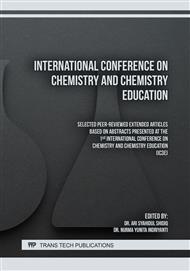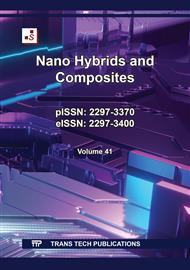[1]
M. Abbasi and M. R. Monazzam, "Assessment of noise effects of wind turbine on the general health of staff at wind farm of Manjil , Iran," vol. 35, no. 1, p.91–98, 2016.
DOI: 10.1177/0263092316628714
Google Scholar
[2]
P. Chanlert and P. Ruamcharoen, "Sound absorption properties of rigid polyurethane foam composites with rubber-wood sawdust as a natural filler," J. Phys. Conf. Ser., vol. 1719, no. 1, 2021.
DOI: 10.1088/1742-6596/1719/1/012062
Google Scholar
[3]
R. Hajizadeh, A. Khavanin, M. Barmar, A. J. Jafari, and S. F. Dehghan, "Improving the sound absorption properties of flexible polyurethane (PU) foam using nanofibers and nanoparticles," Sound Vib., vol. 53, no. 5, p.207–222, 2019.
DOI: 10.32604/sv.2019.06523
Google Scholar
[4]
T. Yang et al., "Sound absorption properties of natural fibers: A review," Sustain., vol. 12, no. 20, p.1–25, 2020.
DOI: 10.3390/su12208477
Google Scholar
[5]
T. Hassan et al., "Factors Affecting Acoustic Properties of Natural-Fiber-Based Materials and Composites: A Review," Textiles, vol. 1, no. 1, p.55–85, 2021.
DOI: 10.3390/textiles1010005
Google Scholar
[6]
D. T. Tran et al., "Green aerogels from rice straw for thermal, acoustic insulation and oil spill cleaning applications," Mater. Chem. Phys., vol. 253, no. June, p.123363, 2020.
DOI: 10.1016/j.matchemphys.2020.123363
Google Scholar
[7]
N. V. Gama, A. Ferreira, and A. Barros-Timmons, "Polyurethane foams: Past, present, and future," Materials, vol. 11, no. 10. MDPI AG, Sep. 2018.
DOI: 10.3390/ma11101841
Google Scholar
[8]
C. Kuranchie, A. Yaya, and Y. D. Bensah, "The effect of natural fibre reinforcement on polyurethane composite foams – A review," Sci. African, vol. 11, p. e00722, 2021.
DOI: 10.1016/j.sciaf.2021.e00722
Google Scholar
[9]
C. Oppon, P. M. Hackney, I. Shyha, and M. Birkett, "Effect of Varying Mixing Ratios and Pre-Heat Temperature on the Mechanical Properties of Polyurethane (PU) Foam," Procedia Eng., vol. 132, p.701–708, 2015.
DOI: 10.1016/j.proeng.2015.12.550
Google Scholar
[10]
M. Kayalvizhi, E. Vakees, J. Suresh, and A. Arun, "Poly(urethane–urea) based on functionalized polystyrene with HMDI: Synthesis and characterization," Arab. J. Chem., vol. 12, no. 8, p.2484–2491, Dec. 2019.
DOI: 10.1016/j.arabjc.2015.04.005
Google Scholar
[11]
M. Kurańska, R. Barczewski, M. Barczewski, A. Prociak, and K. Polaczek, "Thermal insulation and sound absorption properties of open-cell polyurethane foams modified with bio-polyol based on used cooking oil," Materials (Basel)., vol. 13, no. 24, p.1–14, 2020.
DOI: 10.3390/ma13245673
Google Scholar
[12]
A. You, M. A. Y. Be, and I. In, "Reducing room noise using polyurethane- urea biofoam / industrial plywood sawdust waste ( PUU / IPSW )," vol. 020026, no. November, 2020.
DOI: 10.1063/5.0030730
Google Scholar
[13]
C. T. Pham et al., "Comprehensive Investigation of the Behavior of Polyurethane Foams Based on Conventional Polyol and Oligo-Ester-Ether-Diol from Waste Poly(ethylene terephthalate): Fireproof Performances, Thermal Stabilities, and Physicomechanical Properties," ACS Omega, vol. 5, no. 51, p.33053–33063, 2020.
DOI: 10.1021/acsomega.0c04555
Google Scholar
[14]
R. D. Rahmawati, M. Masykuri, and Y. L. Retno Dewi, "Performance of biof oam polyurethane-urea/rice straw waste (Oryza sativa) as a noise reducer," AIP Conf. Proc., vol. 2296, no. November, 2020.
DOI: 10.1063/5.0030733
Google Scholar
[15]
B. Bu, "9-ethox."
Google Scholar
[16]
A. Bayu, D. Nandiyanto, R. Oktiani, and R. Ragadhita, "Indonesian Journal of Science & Technology How to Read and Interpret FTIR Spectroscope of Organic Material," no. 1, p.97–118, 2019.
DOI: 10.17509/ijost.v4i1.15806
Google Scholar
[17]
E. Jayamani, S. Hamdan, M. R. Rahman, and M. K. Bin Bakri, "Study of sound absorption coefficients and characterization of rice straw stem fibers reinforced polypropylene composites," BioResources, vol. 10, no. 2, p.3378–3392, 2015.
DOI: 10.15376/biores.10.2.3378-3392
Google Scholar
[18]
N. Kraitape and C. Thongpin, "Influence of Recycled Polyurethane Polyol on the Properties of Flexible Polyurethane Foams," Energy Procedia, vol. 89, p.186–197, 2016.
DOI: 10.1016/j.egypro.2016.05.025
Google Scholar
[19]
M. H. Dzulkifli, M. Y. Yahya, and R. A. Majid, "Rigid palm oil-based polyurethane foam reinforced with diamine-modified montmorillonite nanoclay," IOP Conf. Ser. Mater. Sci. Eng., vol. 204, no. 1, 2017.
DOI: 10.1088/1757-899X/204/1/012024
Google Scholar
[20]
M. S. M. Azahari, A. Z. M. Rus, S. Kormin, and M. T. Zaliran, "Acoustic properties of polymer foam composites blended with different percentage loadings of natural fiber," IOP Conf. Ser. Mater. Sci. Eng., vol. 244, no. 1, 2017.
DOI: 10.1088/1757-899X/244/1/012009
Google Scholar
[21]
A. E. Tiuc et al., "The analysis of factors that influence the sound absorption coefficient of porous materials," 2014.
Google Scholar
[22]
N. Izzati, R. R. Hannan, and O. Ersoy, "A Review : Characteristics of Noise Absorption Material A Review : Characteristics of Noise Absorption Material," 2017.
Google Scholar
[23]
N. N. M. Hassan and A. Z. M. Rus, "Acoustic performance of green polymer foam from renewable resources after UV exposure," Int. J. Automot. Mech. Eng., vol. 9, no. 1, p.1639–1648, 2014.
DOI: 10.15282/ijame.9.2013.14.0136
Google Scholar
[24]
S. Członka, A. Strakowska, K. Strzelec, A. Kairyte, and A. Kremensas, "Bio-based polyurethane composite foams with improved mechanical, thermal, and antibacterial properties," Materials (Basel)., vol. 13, no. 5, Mar. 2020.
DOI: 10.3390/ma13051108
Google Scholar
[25]
C. S. Carriço, T. Fraga, V. E. Carvalho, and V. M. D. Pasa, "Polyurethane foams for thermal insulation uses produced from castor oil and crude glycerol biopolyols," Molecules, vol. 22, no. 7, Jul. 2017.
DOI: 10.3390/molecules22071091
Google Scholar
[26]
W. S. Residue, "com Thermal Stability Analysis of Polyurethane Foams Made from Microwave Liquefaction Bio-Polyols with and Without Solid Residue," vol. 13, no. 2, p.3346–3361, 2018.
DOI: 10.15376/biores.13.2.3346-3361
Google Scholar
[27]
M. Kirpluks, U. Cabulis, A. Ivdre, M. Kuranska, M. Zieleniewska, and M. Auguscik, "Mechanical and thermal properties of high-density rigid polyurethane foams from renewable resources," in Journal of Renewable Materials, Feb. 2016, vol. 4, no. 1, p.86–100.
DOI: 10.7569/JRM.2015.634132
Google Scholar
[28]
H. M. Ng, N. M. Saidi, F. S. Omar, K. Ramesh, S. Ramesh, and S. Bashir, "Thermogravimetric Analysis of Polymers," in Encyclopedia of Polymer Science and Technology, John Wiley & Sons, Inc., 2018, p.1–29.
DOI: 10.1002/0471440264.pst667
Google Scholar
[29]
C. Zhao, P. Wang, L. Wang, and D. Liu, "Reducing railway noise with porous sound-absorbing concrete slabs," Adv. Mater. Sci. Eng., vol. 2014, 2014.
DOI: 10.1155/2014/206549
Google Scholar



